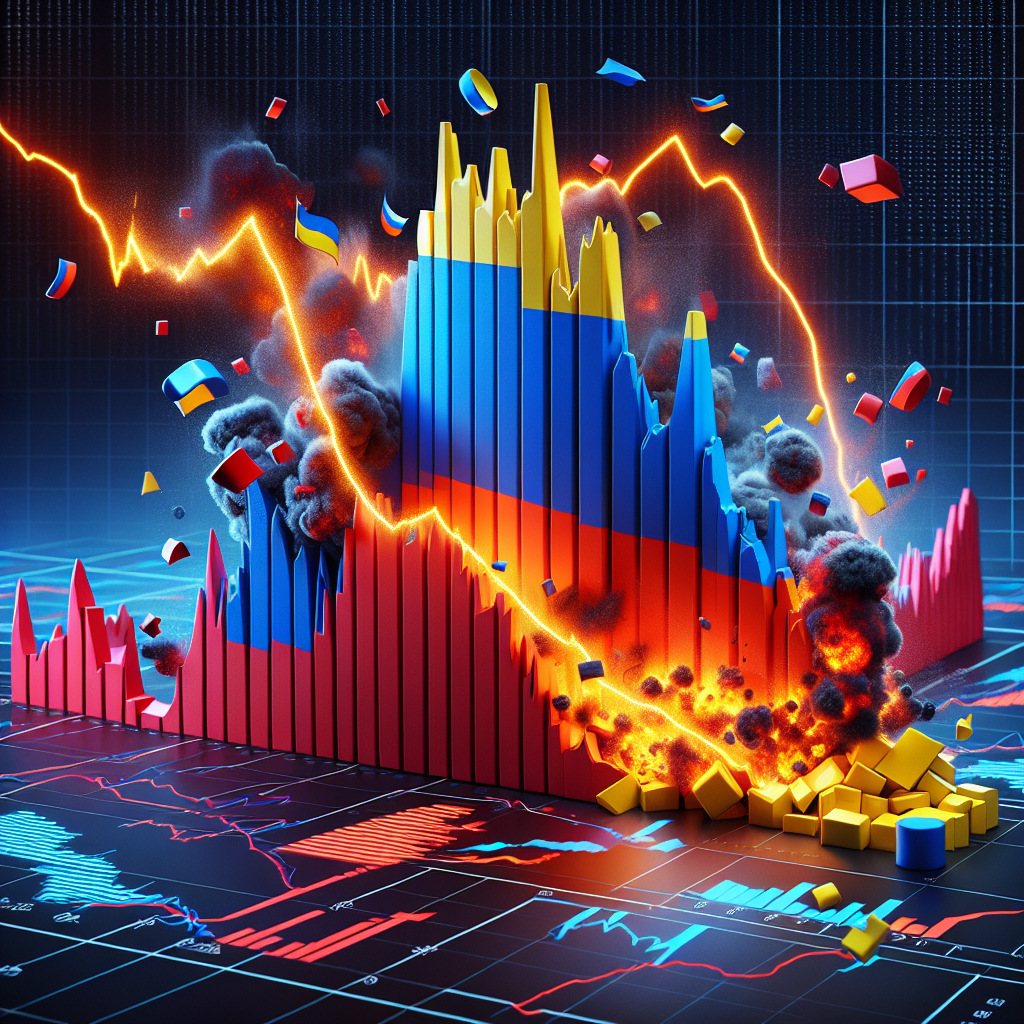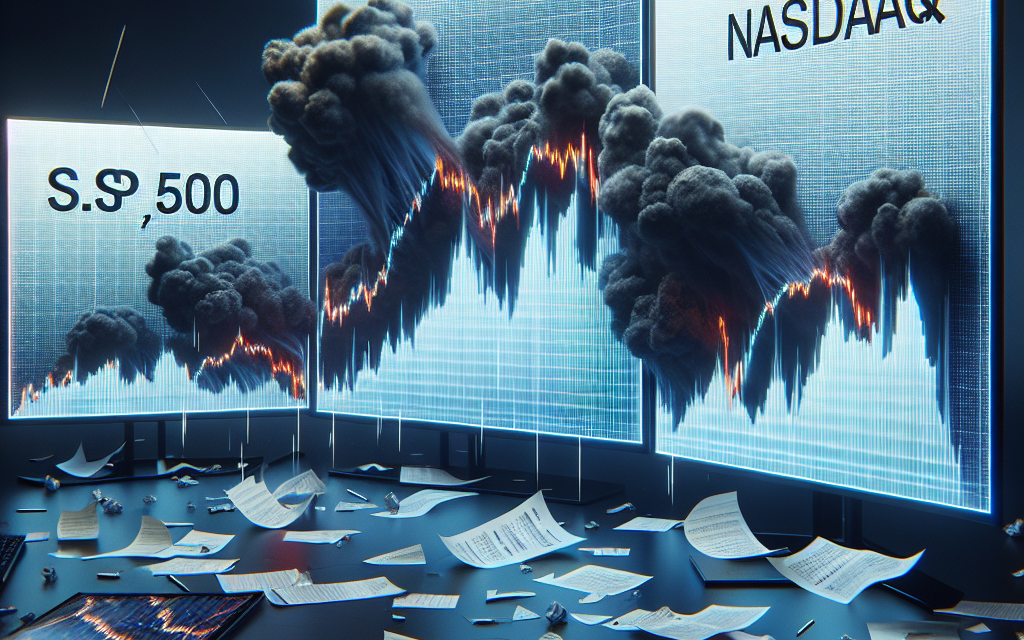“Global Markets Shaken: Indices Dive as Russia-Ukraine Tensions Escalate”
Introduction
Market turmoil has gripped global financial markets as the Dow Jones Industrial Average, S&P 500, and Nasdaq Composite experienced significant declines amid escalating tensions between Russia and Ukraine. Investors are grappling with heightened uncertainty as geopolitical risks intensify, leading to a flight from riskier assets and a surge in market volatility. The conflict has raised concerns over potential disruptions in energy supplies, given Russia’s pivotal role in global energy markets, and has further complicated the global economic recovery from the pandemic. As diplomatic efforts continue, market participants remain on edge, closely monitoring developments and their potential impact on global trade, inflation, and economic stability.
Impact Of Geopolitical Tensions On Global Markets
The recent escalation of tensions between Russia and Ukraine has sent shockwaves through global financial markets, leading to significant declines in major indices such as the Dow Jones Industrial Average, the S&P 500, and the Nasdaq Composite. Investors worldwide are grappling with the uncertainty that geopolitical conflicts inherently bring, and the current situation is no exception. As the conflict intensifies, market participants are increasingly concerned about the potential for broader economic repercussions, which has led to a flight to safety and a reevaluation of risk.
In times of geopolitical unrest, markets often react with heightened volatility, as investors seek to protect their portfolios from unforeseen risks. The current situation between Russia and Ukraine has exacerbated these fears, as the potential for military escalation and economic sanctions looms large. This has resulted in a sell-off across various asset classes, with equities bearing the brunt of the impact. The Dow, S&P 500, and Nasdaq have all experienced significant declines, reflecting the market’s anxiety over the potential fallout from the conflict.
Moreover, the interconnectedness of global markets means that the repercussions of the Russia-Ukraine tensions are not confined to the regions directly involved. Investors are concerned about the potential for disruptions in energy supplies, given Russia’s significant role as a global energy exporter. Any interruption in the flow of oil and gas could have far-reaching consequences for global energy prices, which in turn could impact inflation and economic growth prospects worldwide. This uncertainty has contributed to the volatility seen in commodity markets, with oil prices experiencing sharp fluctuations as traders attempt to price in the potential risks.
In addition to energy markets, the financial sector is also feeling the strain of the geopolitical tensions. Banks and financial institutions with exposure to Russia and Ukraine are facing increased scrutiny, as investors assess the potential impact on their balance sheets. The imposition of economic sanctions could further complicate matters, as financial institutions navigate the complexities of compliance and risk management in an increasingly uncertain environment. This has led to a reassessment of valuations within the sector, contributing to the broader market declines.
Furthermore, the geopolitical tensions have prompted central banks and policymakers to closely monitor the situation, as they weigh the potential implications for monetary policy and economic stability. The prospect of rising inflation, driven by higher energy prices, poses a challenge for central banks already grappling with the delicate balance of supporting economic recovery while keeping inflation in check. Any missteps in policy could exacerbate market volatility, adding another layer of complexity to an already challenging environment.
In conclusion, the ongoing tensions between Russia and Ukraine have underscored the vulnerability of global markets to geopolitical risks. The declines in major indices such as the Dow, S&P 500, and Nasdaq reflect the market’s apprehension about the potential economic and financial fallout from the conflict. As investors navigate this uncertain landscape, the focus will remain on developments in the region and their implications for global markets. The situation serves as a stark reminder of the interconnectedness of today’s financial systems and the need for vigilance in managing geopolitical risks. As events continue to unfold, market participants will be closely watching for any signs of resolution or escalation, which will undoubtedly shape the trajectory of global markets in the coming weeks and months.
Historical Analysis Of Market Reactions To Conflicts
The financial markets have long been sensitive to geopolitical tensions, and the recent plunge in the Dow, S&P 500, and Nasdaq amid the escalating Russia-Ukraine conflict is a testament to this enduring relationship. Historically, markets have reacted to international conflicts with varying degrees of volatility, often reflecting the uncertainty and potential economic repercussions that such events can entail. To understand the current market turmoil, it is instructive to examine past instances where geopolitical tensions have influenced market behavior.
Throughout history, conflicts have often led to immediate market sell-offs as investors seek to mitigate risk. For instance, during the Gulf War in the early 1990s, markets experienced significant volatility. Initially, the uncertainty surrounding the conflict led to a sharp decline in stock prices. However, as the situation became clearer and the conflict’s duration and impact were better understood, markets began to stabilize and eventually recover. This pattern of initial panic followed by eventual recovery is a common theme in market reactions to geopolitical events.
Similarly, the aftermath of the September 11 attacks in 2001 saw a dramatic market downturn. The attacks not only caused immediate economic disruption but also led to heightened fears of further instability. The Dow Jones Industrial Average fell by over 600 points on the first day of trading after the attacks, marking one of the largest single-day declines in history at that time. However, as the U.S. government implemented measures to restore confidence and security, markets gradually rebounded, demonstrating resilience in the face of adversity.
In more recent history, the annexation of Crimea by Russia in 2014 also had a noticeable impact on global markets. The geopolitical uncertainty surrounding Russia’s actions led to a temporary decline in stock prices, particularly in European markets that were more directly affected by the situation. Nevertheless, as diplomatic efforts progressed and the immediate threat of further escalation diminished, markets began to recover, underscoring the importance of geopolitical clarity in restoring investor confidence.
The current situation between Russia and Ukraine has similarly unsettled markets, with investors wary of the potential for broader economic implications. The interconnectedness of global economies means that regional conflicts can have far-reaching effects, influencing everything from energy prices to supply chain stability. As a result, investors often react by reallocating assets, seeking safe havens such as gold or government bonds, and reducing exposure to riskier equities.
While the immediate market reaction to the Russia-Ukraine tensions has been negative, historical analysis suggests that markets are likely to stabilize once the situation becomes clearer. Investors typically adjust to new realities, and markets have shown a remarkable ability to recover from geopolitical shocks over time. However, the duration and severity of the current conflict will play a crucial role in determining the extent and speed of market recovery.
In conclusion, while geopolitical tensions invariably lead to market volatility, historical patterns indicate that such turmoil is often temporary. As investors navigate the current landscape, understanding past market reactions to conflicts can provide valuable insights into potential future trends. Ultimately, while the path to recovery may be uncertain, history suggests that markets possess an inherent resilience that enables them to weather geopolitical storms.
Strategies For Investors During Market Volatility
In the wake of escalating tensions between Russia and Ukraine, global financial markets have been thrown into a state of turmoil, with major indices such as the Dow Jones Industrial Average, the S&P 500, and the Nasdaq experiencing significant declines. This volatility has left many investors grappling with uncertainty and seeking strategies to navigate these turbulent times. Understanding the underlying causes of market fluctuations and adopting a strategic approach can help investors mitigate risks and potentially capitalize on opportunities that arise during periods of instability.
To begin with, it is crucial for investors to maintain a long-term perspective. Market volatility, while unsettling, is not uncommon and often reflects short-term reactions to geopolitical events, economic data, or shifts in investor sentiment. By focusing on long-term goals and maintaining a diversified portfolio, investors can better withstand the temporary ups and downs of the market. Diversification, in particular, is a key strategy that involves spreading investments across various asset classes, sectors, and geographic regions to reduce exposure to any single risk factor.
Moreover, during times of heightened market volatility, it is advisable for investors to reassess their risk tolerance and investment objectives. This reassessment can help ensure that their portfolio aligns with their financial goals and risk appetite. For some, this may mean reducing exposure to high-risk assets, while others may see an opportunity to invest in undervalued stocks or sectors that have been disproportionately affected by market swings. It is important to remember that each investor’s situation is unique, and strategies should be tailored to individual circumstances.
In addition to diversification and risk assessment, maintaining liquidity is another essential strategy during volatile periods. Having access to cash or cash-equivalent assets allows investors to take advantage of buying opportunities when prices are low or to meet unexpected financial needs without having to sell investments at a loss. This liquidity can serve as a buffer against market fluctuations and provide flexibility in decision-making.
Furthermore, investors should consider the role of professional advice in navigating market volatility. Financial advisors can offer valuable insights and guidance, helping investors make informed decisions based on a comprehensive analysis of market conditions and individual financial situations. Advisors can also assist in developing a disciplined investment plan that emphasizes consistency and adherence to long-term objectives, even in the face of short-term market disruptions.
It is also worth noting that market volatility can present opportunities for investors who are willing to embrace a contrarian approach. By identifying sectors or companies that have been unduly punished by market sentiment, investors may find attractive entry points for long-term growth. However, this approach requires careful research and a thorough understanding of the underlying fundamentals to distinguish between temporary setbacks and genuine value opportunities.
In conclusion, while the current market turmoil driven by Russia-Ukraine tensions poses challenges for investors, it also underscores the importance of strategic planning and disciplined investing. By maintaining a long-term perspective, diversifying portfolios, reassessing risk tolerance, ensuring liquidity, seeking professional advice, and potentially adopting a contrarian mindset, investors can navigate the complexities of market volatility with greater confidence. Ultimately, these strategies can help investors not only protect their assets but also position themselves to benefit from future market recoveries.
The Role Of Safe-Haven Assets In Times Of Crisis

In times of geopolitical uncertainty, such as the ongoing tensions between Russia and Ukraine, financial markets often experience significant volatility. This turbulence is evident in the recent plunges of major indices like the Dow Jones Industrial Average, the S&P 500, and the Nasdaq Composite. Investors, faced with the unpredictability of such crises, frequently turn to safe-haven assets as a means of preserving capital and mitigating risk. Understanding the role of these assets during periods of market turmoil is crucial for both individual and institutional investors seeking stability amidst chaos.
Safe-haven assets are financial instruments that are expected to retain or even increase in value during times of market stress. Traditionally, these include gold, U.S. Treasury bonds, and the Swiss franc, among others. The appeal of these assets lies in their perceived stability and reliability, which contrasts sharply with the volatility of equities during geopolitical crises. For instance, gold has long been considered a store of value, often appreciating when confidence in fiat currencies wanes. Similarly, U.S. Treasury bonds are backed by the full faith and credit of the U.S. government, making them a preferred choice for risk-averse investors.
The current Russia-Ukraine tensions have underscored the importance of these safe-haven assets. As the conflict escalates, investors are increasingly wary of the potential economic repercussions, including disruptions to global supply chains and energy markets. Consequently, there has been a noticeable shift in capital flows towards assets perceived as safer bets. This movement is not merely a reaction to immediate threats but also a strategic repositioning to hedge against longer-term uncertainties.
Moreover, the role of safe-haven assets extends beyond mere capital preservation. They also serve as a barometer for market sentiment, providing insights into investor confidence and risk appetite. For example, a surge in gold prices or a rally in U.S. Treasury bonds often signals heightened fear and uncertainty in the market. Conversely, a decline in these assets might indicate a return to risk-taking behavior and optimism about future economic conditions.
However, it is essential to recognize that the effectiveness of safe-haven assets can vary depending on the nature and duration of the crisis. While gold and U.S. Treasuries have historically performed well during geopolitical tensions, other assets like the Swiss franc may not always exhibit the same resilience. Additionally, the interconnectedness of global financial markets means that no asset is entirely immune to systemic risks. Therefore, investors must carefully assess their portfolios and consider a diversified approach to risk management.
In conclusion, the recent market turmoil triggered by Russia-Ukraine tensions highlights the critical role of safe-haven assets in times of crisis. These assets offer a refuge for investors seeking to navigate the uncertainties of geopolitical conflicts and economic disruptions. By providing stability and serving as indicators of market sentiment, safe-haven assets play an indispensable role in the broader financial ecosystem. As the situation continues to evolve, investors must remain vigilant and adaptable, leveraging the protective qualities of these assets while staying attuned to the dynamic landscape of global markets.
Comparing The Current Market Plunge To Past Crises
The recent market turmoil, characterized by significant plunges in the Dow, S&P 500, and Nasdaq, has drawn inevitable comparisons to past financial crises. As investors grapple with the implications of the ongoing Russia-Ukraine tensions, it is crucial to examine how this current situation aligns with or diverges from previous market downturns. By analyzing historical patterns, we can gain insights into the potential trajectory of the markets and the broader economic implications.
To begin with, the immediate market reaction to geopolitical tensions is not unprecedented. Historically, markets have often responded with volatility to geopolitical events, as uncertainty tends to drive investors towards safer assets. For instance, during the Gulf War in the early 1990s, markets experienced significant fluctuations as investors assessed the potential impact on global oil supplies and economic stability. Similarly, the 2003 invasion of Iraq saw initial market declines, followed by a recovery as the situation stabilized. In both cases, the markets eventually rebounded, suggesting that while geopolitical tensions can cause short-term disruptions, they do not necessarily lead to prolonged downturns.
However, comparing the current market plunge to the 2008 financial crisis reveals some stark differences. The 2008 crisis was primarily driven by systemic issues within the financial sector, including the collapse of major financial institutions and a severe credit crunch. The resulting market crash was not merely a reaction to external events but was rooted in deep-seated structural problems. In contrast, the current market decline is largely a response to external geopolitical factors, rather than inherent weaknesses within the financial system. This distinction is crucial, as it suggests that the current turmoil may be more transient, provided that the geopolitical situation does not escalate further.
Moreover, the COVID-19 pandemic offers another point of comparison. The pandemic-induced market crash in early 2020 was characterized by unprecedented uncertainty and a global economic shutdown. However, the rapid response from governments and central banks, through fiscal stimulus and monetary easing, facilitated a swift recovery. In the current scenario, while central banks remain vigilant, the tools available to mitigate geopolitical risks are more limited compared to those used during a health crisis. This limitation underscores the importance of diplomatic efforts in resolving the Russia-Ukraine tensions to restore market stability.
Furthermore, it is essential to consider the role of technology and globalization in shaping market dynamics today. The interconnectedness of global markets means that geopolitical events can have far-reaching impacts, affecting supply chains, commodity prices, and investor sentiment worldwide. This interconnectedness was less pronounced during earlier crises, such as the dot-com bubble burst in the early 2000s, which was more contained within the technology sector. Today, the ripple effects of geopolitical tensions are felt across various sectors, amplifying market volatility.
In conclusion, while the current market plunge shares some similarities with past crises, it is distinct in its origins and potential outcomes. The primary driver is geopolitical tension, rather than systemic financial issues or a global health crisis. As such, the resolution of the Russia-Ukraine conflict will be pivotal in determining the market’s trajectory. Investors and policymakers alike must remain vigilant, drawing lessons from history while adapting to the unique challenges of the present. By doing so, they can navigate the current turmoil with a balanced perspective, informed by both past experiences and current realities.
Long-Term Implications Of The Russia-Ukraine Conflict On Global Trade
The ongoing conflict between Russia and Ukraine has sent ripples through global markets, with the Dow, S&P 500, and Nasdaq experiencing significant declines. This market turmoil is not merely a short-term reaction but could have profound long-term implications for global trade. As tensions escalate, the interconnected nature of the global economy means that the effects of this conflict are likely to be felt far beyond the immediate region.
To begin with, the geopolitical instability in Eastern Europe has led to increased volatility in financial markets worldwide. Investors, wary of the potential for further escalation, have been quick to pull back from riskier assets, leading to sharp declines in major stock indices. This uncertainty is compounded by the fact that both Russia and Ukraine are key players in several critical global markets. Russia, as one of the world’s largest energy producers, plays a pivotal role in the supply of oil and natural gas. Any disruption in this supply chain could lead to significant increases in energy prices, which would have a cascading effect on global trade and economic stability.
Moreover, Ukraine is a major exporter of agricultural products, particularly grains such as wheat and corn. The conflict has already disrupted planting and harvesting activities, raising concerns about food security and price stability in regions that rely heavily on these imports. As a result, countries that depend on Ukrainian agricultural exports may face shortages and increased costs, which could lead to inflationary pressures and social unrest.
In addition to these direct impacts, the conflict has also prompted a reevaluation of global supply chains. Companies that have traditionally relied on Eastern Europe for manufacturing and raw materials are now seeking alternative sources to mitigate risk. This shift could lead to a realignment of trade relationships and a reconfiguration of supply chains, with long-term implications for global trade patterns. As businesses adapt to this new reality, there may be increased investment in regions that are perceived as more stable, potentially altering the balance of economic power.
Furthermore, the imposition of economic sanctions on Russia by Western nations has added another layer of complexity to the situation. These sanctions, aimed at pressuring Russia to de-escalate the conflict, have had significant repercussions for global trade. They have not only restricted the flow of goods and services between Russia and the rest of the world but have also led to retaliatory measures that further complicate international trade relations. The long-term impact of these sanctions is still uncertain, but they could lead to a more fragmented global economy, with countries forming new alliances and trade blocs based on geopolitical considerations rather than purely economic ones.
In conclusion, the Russia-Ukraine conflict has far-reaching implications for global trade that extend well beyond the immediate market turmoil. The disruption of key supply chains, the reevaluation of trade relationships, and the imposition of economic sanctions all contribute to an increasingly complex and uncertain global economic landscape. As the situation continues to evolve, businesses and policymakers alike will need to navigate these challenges with caution and foresight, recognizing that the decisions made today will shape the future of global trade for years to come.
How Central Banks Respond To Geopolitical Market Shocks
In the wake of escalating tensions between Russia and Ukraine, global financial markets have experienced significant volatility, with major indices such as the Dow Jones Industrial Average, the S&P 500, and the Nasdaq Composite suffering substantial declines. This market turmoil has prompted investors and policymakers alike to scrutinize the potential economic repercussions of geopolitical conflicts. Central banks, as key stewards of economic stability, play a crucial role in responding to such shocks. Their actions, aimed at mitigating the adverse effects on financial markets and the broader economy, are multifaceted and require a delicate balance between immediate intervention and long-term policy adjustments.
Initially, central banks may respond to geopolitical market shocks by providing liquidity to financial markets. This is often achieved through open market operations, where central banks purchase government securities to inject cash into the banking system. By doing so, they aim to ensure that financial institutions have sufficient liquidity to meet their obligations, thereby preventing a credit crunch that could exacerbate market instability. Moreover, central banks may also lower interest rates to encourage borrowing and investment, which can help stimulate economic activity during periods of uncertainty.
In addition to these immediate measures, central banks closely monitor the potential impact of geopolitical tensions on inflation and economic growth. Geopolitical conflicts can disrupt supply chains, leading to shortages and price increases for certain goods. In such scenarios, central banks face the challenge of balancing the need to support economic growth with the risk of rising inflation. If inflationary pressures become pronounced, central banks might be compelled to tighten monetary policy, even if it means risking slower economic growth. Conversely, if the conflict leads to a significant economic slowdown, central banks may opt for more accommodative policies to bolster growth.
Furthermore, central banks often engage in communication strategies to manage market expectations and maintain confidence. By providing clear guidance on their policy intentions, central banks can help reduce uncertainty and stabilize financial markets. For instance, during periods of heightened geopolitical tensions, central banks may emphasize their commitment to maintaining price stability and supporting economic growth, thereby reassuring investors and the public. This forward guidance can be a powerful tool in shaping market perceptions and mitigating panic-driven sell-offs.
In some cases, central banks may also coordinate with other international financial institutions and governments to address the broader implications of geopolitical conflicts. Such coordination can involve joint efforts to stabilize currency markets, provide financial assistance to affected countries, or implement sanctions against aggressor nations. By working together, central banks and other stakeholders can enhance the effectiveness of their responses and minimize the global economic fallout from geopolitical shocks.
Ultimately, the response of central banks to geopolitical market shocks is a complex and dynamic process that requires careful consideration of various economic indicators and potential scenarios. While immediate interventions such as liquidity provision and interest rate adjustments are crucial, central banks must also remain vigilant in assessing the longer-term implications of geopolitical tensions on inflation, growth, and financial stability. Through a combination of monetary policy tools, communication strategies, and international cooperation, central banks strive to navigate the challenges posed by geopolitical conflicts and uphold their mandate of ensuring economic stability. As the situation between Russia and Ukraine continues to evolve, the actions of central banks will remain a focal point for investors and policymakers seeking to understand and mitigate the economic impact of this ongoing crisis.
Q&A
1. **What caused the market turmoil?**
The market turmoil was primarily caused by escalating tensions between Russia and Ukraine, which raised concerns about geopolitical stability and potential economic impacts.
2. **How did the Dow Jones Industrial Average react?**
The Dow Jones Industrial Average experienced a significant plunge as investors reacted to the heightened geopolitical tensions.
3. **What was the impact on the S&P 500?**
The S&P 500 also saw a substantial decline, reflecting widespread investor anxiety and uncertainty in the market.
4. **How did the Nasdaq Composite perform?**
The Nasdaq Composite dropped sharply, with technology stocks being particularly affected by the market volatility.
5. **What sectors were most affected by the turmoil?**
Sectors such as technology, financials, and energy were among the most affected, with investors pulling back from riskier assets.
6. **What are the potential economic implications of the Russia-Ukraine tensions?**
Potential economic implications include disruptions in energy supplies, increased volatility in global markets, and potential sanctions that could affect international trade.
7. **How are investors responding to the situation?**
Investors are responding by seeking safer assets, such as gold and government bonds, and reducing exposure to riskier equities amid the uncertainty.
Conclusion
The market turmoil, characterized by significant declines in the Dow, S&P 500, and Nasdaq, underscores the profound impact geopolitical tensions, such as the Russia-Ukraine conflict, can have on global financial markets. Investor sentiment is heavily influenced by uncertainty and potential economic repercussions, leading to increased volatility and risk aversion. This situation highlights the interconnectedness of global economies and the sensitivity of markets to geopolitical events, emphasizing the need for investors to remain vigilant and adaptable in the face of such crises.





